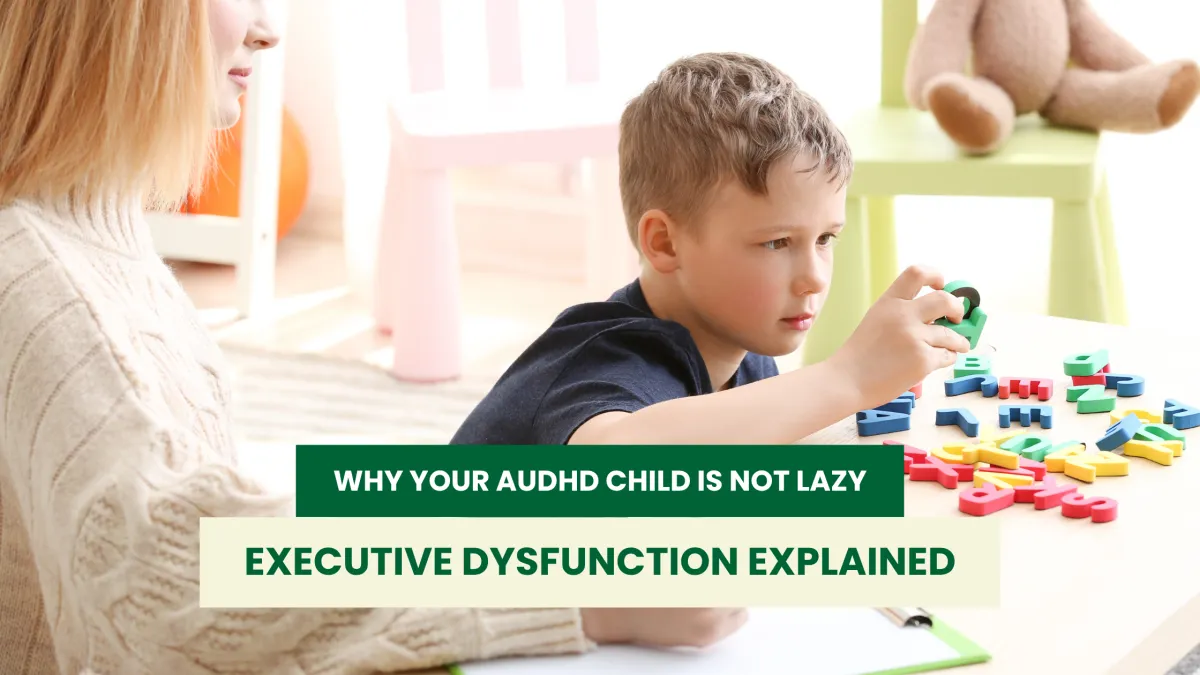
Why Your AuDHD Child Is Not Lazy
“They know what to do, so why won’t they just do it?”
If you're the parent of a child with both autism and ADHD—a neurotype known as AuDHD—you may have asked this question more than once. Maybe you've watched your child hyperfocus on their favorite hobby for hours but completely forget to do their homework. Maybe you see them melt down over small transitions or avoid tasks that seem entirely within their ability.
This disconnect is incredibly frustrating for parents, teachers, and even for the kids themselves. But here’s the truth:
What Is Executive Functioning?
Executive functioning refers to a set of mental skills that help us manage time, sustain attention, switch tasks, regulate emotions, and plan ahead. Think of it like the brain’s CEO—directing and coordinating what we do, how we do it, and when we do it.
According to the DSM-5-TR (American Psychiatric Association, 2022), both ADHD and autism spectrum disorder can impair executive function in different but overlapping ways:
Kids with ADHD often struggle with initiation, impulse control, and sustained attention.
Kids with autism may struggle with flexibility, planning, and shifting attention.
Kids with AuDHD? They experience both.
Why AuDHD Kids Struggle So Much with Everyday Tasks
Here’s the paradox: your child may be brilliant, capable, and articulate—yet unable to remember to bring their backpack, start their homework, or clean their room.
That’s because executive dysfunction interferes with the ability to translate intention into action. It’s not about willpower. It’s about neurology.
Some signs of executive dysfunction in AuDHD kids:
Task initiation problems (“I know what to do, but I can’t get started.”)
Working memory challenges (Forgetting steps of a task mid-process)
Time blindness (Difficulty estimating how long things take)
Emotional flooding (Big feelings derail cognitive processing)
Avoidance behaviors (Not laziness—but a shutdown or coping mechanism)
Executive Dysfunction Is Not Defiance
One of the biggest mistakes adults make is interpreting executive dysfunction as misbehavior.
You might think:
"They're just being oppositional."
"They always have an excuse."
"They're so smart—they should know better."
But none of these assumptions take into account how neurological fatigue, sensory overload, or anxiety can paralyze a child who seems "fine" on the outside. Kids with AuDHD are often internally overwhelmed but externally misunderstood.
Instead of asking, "Why aren't they doing this?" try asking:
"What might be making this hard for them right now?"
"What kind of support would help them start?"
"Is this a can't or a won't?"
More often than not, it’s a can’t.
Real-Life Examples
Example 1: The Clean Room Battle
You ask your 10-year-old to clean their room. They say "OK," but 20 minutes later, they’re lying on the floor surrounded by Legos. You assume they’re ignoring you. But what's really happening?
They may be too overwhelmed to know where to start.
They may have forgotten the instructions as soon as you left.
They may be experiencing sensory overload from the mess.
Support tip: Break it down. Try: "Let’s start by putting the clothes in the hamper."
Example 2: The Missing Homework
Your teen did their homework but forgot to turn it in. Again. You assume they don’t care. But what might really be happening?
They got distracted between classes.
They’re ashamed they forgot and didn’t want to explain.
They struggle with working memory and transitions.
Support tip: Help them build a checklist routine and gently problem-solve without shaming.
How to Support AuDHD Kids with Executive Dysfunction
1. Use External Supports (aka "Scaffolding")
Visual checklists
Timers and reminders
Written schedules and step-by-step guides
Scaffolding doesn’t make your child dependent. It builds the pathways for future independence.
2. Co-Regulate Before You Redirect
Before problem-solving, meet them in the moment. If your child is dysregulated, nothing you say will land.
Offer a sensory break
Sit quietly with them
Reflect back their emotion: "That felt really frustrating."
3. Don’t Wait for Motivation
Kids with AuDHD often need momentum, not motivation, to get started. Help them begin a task by:
Doing the first step with them
Using a countdown: "In 3 minutes, we’ll start together."
Giving a choice: "Math or reading first?"
4. Be Curious, Not Controlling
Instead of lecturing, ask:
"What part of this feels hardest right now?"
"How can I help your brain feel ready?"
This promotes self-awareness and problem-solving.
5. Celebrate Progress, Not Perfection
Executive function growth is slow, non-linear, and full of setbacks. Praise effort, not outcomes.
"I noticed you remembered your planner!"
"You worked through a tough task—I’m proud of you."
Final Thoughts: Reframing the Narrative
If you walk away with one message, let it be this:
Your AuDHD child is not lazy.
They are likely working harder than most of their peers just to stay regulated, follow instructions, and manage their day. When we label executive dysfunction as laziness, we create shame. When we recognize it for what it is, we create support.
By shifting the narrative from punishment to partnership, we don’t just help our kids succeed—we help them believe in themselves.
References
American Psychiatric Association. (2022). Diagnostic and statistical manual of mental disorders (5th ed., text rev.; DSM-5-TR). https://doi.org/10.1176/appi.books.9780890425787
Brown, T. E. (2013). A new understanding of ADHD in children and adults: Executive function impairments. Routledge.
Barkley, R. A. (2012). Executive functions: What they are, how they work, and why they evolved. Guilford Press.
